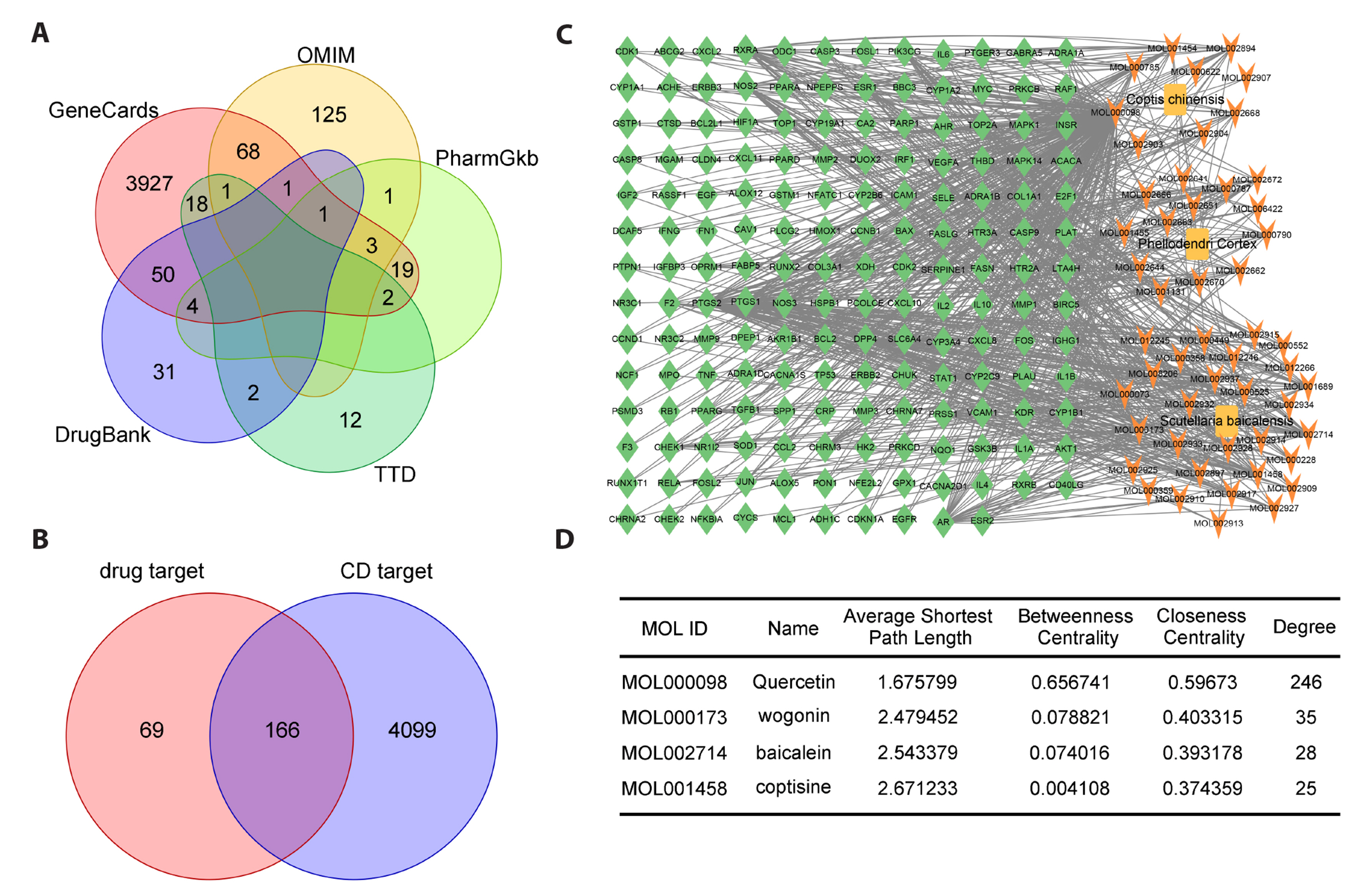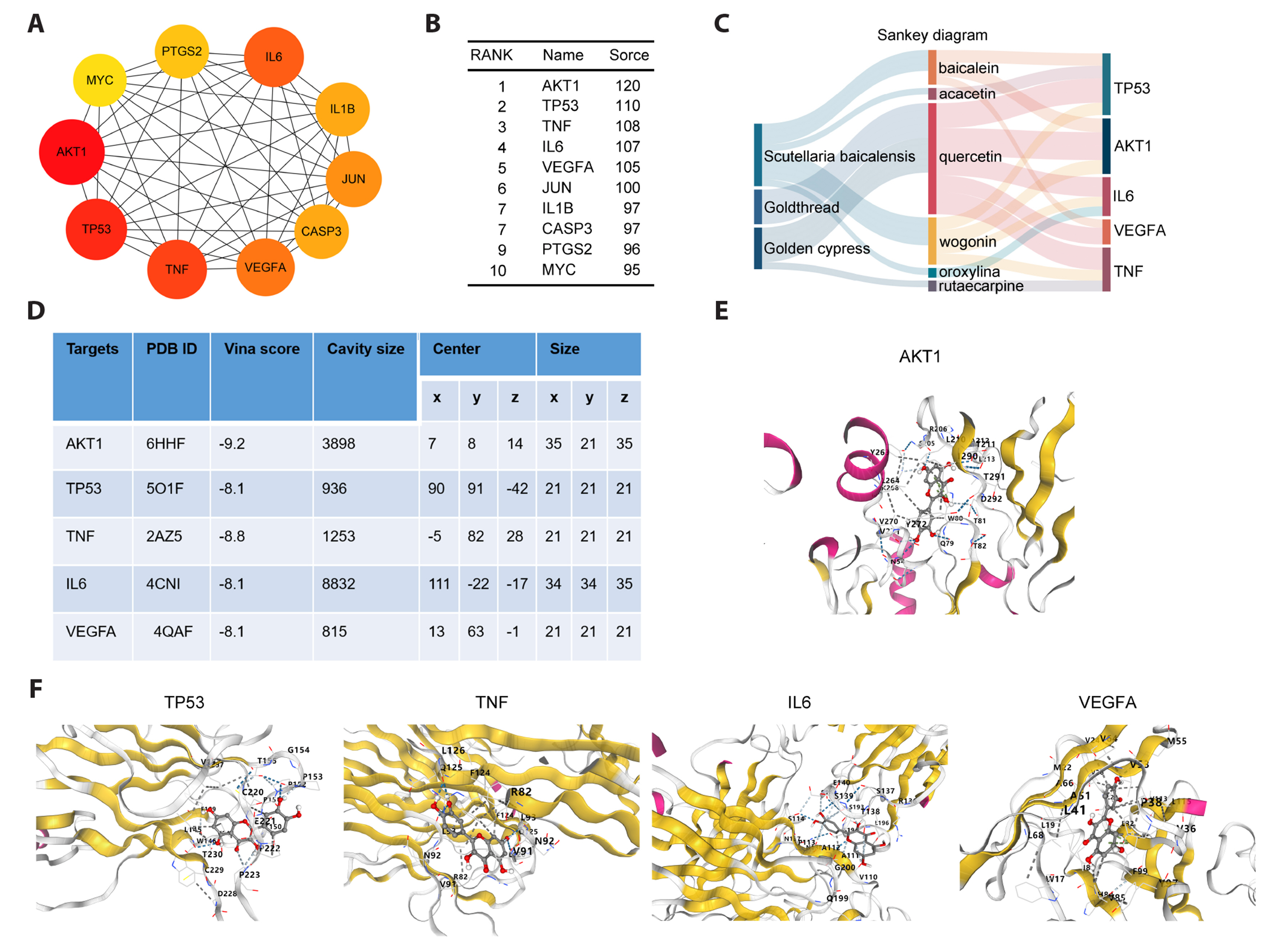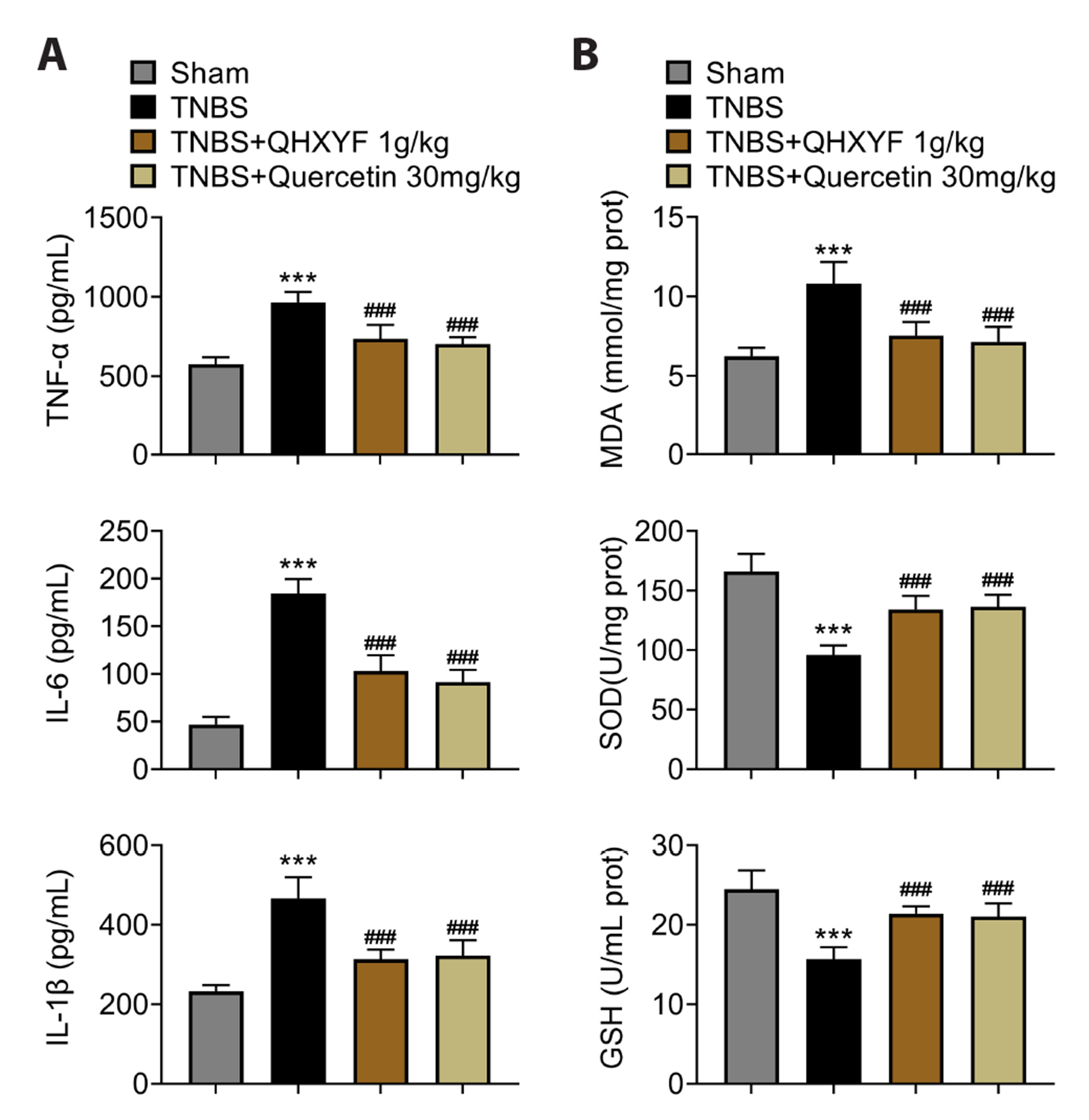Korean J Physiol Pharmacol.
2023 Jul;27(4):365-374. 10.4196/kjpp.2023.27.4.365.
Network pharmacology and molecular docking reveal the mechanism of Qinghua Xiaoyong Formula in Crohn’s disease
- Affiliations
-
- 1Department of Proctology, Shuguang Hospital Affiliated to Shanghai University of Traditional Chinese Medicine, Shanghai 201203, China
- KMID: 2544138
- DOI: http://doi.org/10.4196/kjpp.2023.27.4.365
Abstract
- Crohn's disease (CD) is a chronic inflammatory illness of the digestive system with unknown etiology, and its incidence is increasing worldwide. However, there are currently no effective treatments or medications available for individuals with CD. Therefore, novel therapeutic strategies are urgently needed. The bioactive compounds and targets associated with compounds of Qinghua Xiaoyong Formula (QHXYF) were examined using The Traditional Chinese Medicine Systems Pharmacology database, and 5 disease target databases were also used to identify CD-related disease targets. A total of 166 overlapping targets were identified from QHXYF-related and CD-related disease targets and they were found to be enriched in oxidative stress-related pathways and the PI3K/AKT signaling pathway. Molecular docking was then used to predict how the bioactive compounds would bind to the hub targets. It was found that quercetin could be the core bioactive compound and had good binding affinity to the top 5 hub targets. Finally, animal experiments were performed to further validate the findings, and the results revealed that QHXYF or quercetin inhibited 2,4,6-trinitrobenzenesulfonic acid-induced inflammation and oxidative stress processes by inhibiting the PI3K/AKT pathway, thereby improving CD symptoms. These findings suggest that QHXYF and quercetin may be potential novel treatments for CD.
Keyword
Figure
Reference
-
1. Roda G, Chien Ng S, Kotze PG, Argollo M, Panaccione R, Spinelli A, Kaser A, Peyrin-Biroulet L, Danese S. 2020; Crohn's disease. Nat Rev Dis Primers. 6:22. Erratum in: Nat Rev Dis Primers. 2020;6:26. Erratum in: Nat Rev Dis Primers. 2020;6:42. Erratum in: Nat Rev Dis Primers. 2020;6:51. DOI: 10.1038/s41572-020-0156-2. PMID: 32242028.
Article2. Burge K, Gunasekaran A, Eckert J, Chaaban H. 2019; Curcumin and intestinal inflammatory diseases: molecular mechanisms of protection. Int J Mol Sci. 20:1912. DOI: 10.3390/ijms20081912. PMID: 31003422. PMCID: PMC6514688. PMID: c9370cbd52b04bb7a22fc1de731c284e.
Article3. Ballini A, Santacroce L, Cantore S, Bottalico L, Dipalma G, Topi S, Saini R, De Vito D, Inchingolo F. 2019; Probiotics efficacy on oxidative stress values in inflammatory bowel disease: a randomized double-blinded placebo-controlled pilot study. Endocr Metab Immune Disord Drug Targets. 19:373–381. DOI: 10.2174/1871530319666181221150352. PMID: 30574857.
Article4. Yu B, Yin YX, Tang YP, Wei KL, Pan ZG, Li KZ, Guo XW, Hu BL. 2021; Diagnostic and predictive value of immune-related genes in Crohn's disease. Front Immunol. 12:643036. DOI: 10.3389/fimmu.2021.643036. PMID: 33936061. PMCID: PMC8085323. PMID: 51f8ee1dadc144dab1d5a60e6a48dd87.
Article5. Chen M, Ding Y, Tong Z. 2020; Efficacy and safety of Sophora flavescens (Kushen) based traditional Chinese medicine in the treatment of ulcerative colitis: clinical evidence and potential mechanisms. Front Pharmacol. 11:603476. DOI: 10.3389/fphar.2020.603476. PMID: 33362558. PMCID: PMC7758483. PMID: fde00a9930194e1d9ceaa5a2b9a9df08.
Article6. Xu M, Duan XY, Chen QY, Fan H, Hong ZC, Deng SJ, Nan Z, Wu H, Dong YL, Liu YJ, Zhou CZ. 2019; Effect of compound sophorae decoction on dextran sodium sulfate (DSS)-induced colitis in mice by regulating Th17/Treg cell balance. Biomed Pharmacother. 109:2396–2408. DOI: 10.1016/j.biopha.2018.11.087. PMID: 30551499.
Article7. Wan F, Wang M, Zhong R, Chen L, Han H, Liu L, Zhao Y, Lv H, Hou F, Yi B, Zhang H. 2022; Supplementation with Chinese medicinal plant extracts from Lonicera hypoglauca and Scutellaria baicalensis mitigates colonic inflammation by regulating oxidative stress and gut microbiota in a colitis mouse model. Front Cell Infect Microbiol. 11:798052. DOI: 10.3389/fcimb.2021.798052. PMID: 35059326. PMCID: PMC8763710. PMID: bc8c567eff69460f94372046c230bd61.
Article8. Xie Q, Li H, Ma R, Ren M, Li Y, Li J, Chen H, Chen Z, Gong D, Wang J. 2022; Effect of Coptis chinensis franch and Magnolia officinalis on intestinal flora and intestinal barrier in a TNBS-induced ulcerative colitis rats model. Phytomedicine. 97:153927. DOI: 10.1016/j.phymed.2022.153927. PMID: 35030387.
Article9. Mao YF, Li YQ, Zong L, You XM, Lin FQ, Jiang L. 2010; Methanol extract of Phellodendri cortex alleviates lipopolysaccharide-induced acute airway inflammation in mice. Immunopharmacol Immunotoxicol. 32:110–115. DOI: 10.3109/08923970903193325. PMID: 19811108.
Article10. Ru J, Li P, Wang J, Zhou W, Li B, Huang C, Li P, Guo Z, Tao W, Yang Y, Xu X, Li Y, Wang Y, Yang L. 2014; TCMSP: a database of systems pharmacology for drug discovery from herbal medicines. J Cheminform. 6:13. DOI: 10.1186/1758-2946-6-13. PMID: 24735618. PMCID: PMC4001360.
Article11. Liu J, Zhang L, Wang Z, Chen S, Feng S, He Y, Zhang S. 2022; Network pharmacology-based strategy to identify the pharmacological mechanisms of Pulsatilla decoction against Crohn's disease. Front Pharmacol. 13:844685. DOI: 10.3389/fphar.2022.844685. PMID: 35450039. PMCID: PMC9016333. PMID: 1ef87403ce8f4b2682415fb9acb85ae4.
Article12. Qi X, Qi C, Kang X, Hu Y, Han W. 2020; Identification of candidate genes and prognostic value analysis in patients with PDL1-positive and PDL1-negative lung adenocarcinoma. PeerJ. 8:e9362. DOI: 10.7717/peerj.9362. PMID: 32607285. PMCID: PMC7315620. PMID: fb375c74400141fda27f5a0ab4220e25.
Article13. Liu Y, Grimm M, Dai WT, Hou MC, Xiao ZX, Cao Y. 2020; CB-Dock: a web server for cavity detection-guided protein-ligand blind docking. Acta Pharmacol Sin. 41:138–144. DOI: 10.1038/s41401-019-0228-6. PMID: 31263275. PMCID: PMC7471403.
Article14. Cooper HS, Murthy SN, Shah RS, Sedergran DJ. 1993; Clinicopathologic study of dextran sulfate sodium experimental murine colitis. Lab Invest. 69:238–249. PMID: 8350599.15. Lu S, Guo M, Fan Z, Chen Y, Shi X, Gu C, Yang Y. 2019; Elevated TRIP13 drives cell proliferation and drug resistance in bladder cancer. Am J Transl Res. 11:4397–4410. PMID: 31396344. PMCID: PMC6684882.16. Shen M, Zhang B, Wang M, Meng L, Lv B. 2020; Mica can alleviate TNBS-induced colitis in mice by reducing angiotensin II and IL-17A and increasing angiotensin-converting enzyme 2, angiotensin 1-7, and IL-10. Mediators Inflamm. 2020:3070345. DOI: 10.1155/2020/3070345. PMID: 33100902. PMCID: PMC7569463. PMID: 9cbf498cc8ea485aa69914804ce72a27.
Article17. Zuo H, Zhang Q, Su S, Chen Q, Yang F, Hu Y. 2018; A network pharmacology-based approach to analyse potential targets of traditional herbal formulas: an example of Yu Ping Feng decoction. Sci Rep. 8:11418. DOI: 10.1038/s41598-018-29764-1. PMID: 30061691. PMCID: PMC6065326.
Article18. Luceri C, Bigagli E, Agostiniani S, Giudici F, Zambonin D, Scaringi S, Ficari F, Lodovici M, Malentacchi C. 2019; Analysis of oxidative stress-related markers in Crohn's disease patients at surgery and correlations with clinical findings. Antioxidants (Basel). 8:378. DOI: 10.3390/antiox8090378. PMID: 31489956. PMCID: PMC6771139. PMID: 1c479193c06041068ce1facb08f4e2bc.
Article19. Bhattacharyya A, Chattopadhyay R, Mitra S, Crowe SE. 2014; Oxidative stress: an essential factor in the pathogenesis of gastrointestinal mucosal diseases. Physiol Rev. 94:329–354. DOI: 10.1152/physrev.00040.2012. PMID: 24692350. PMCID: PMC4044300.
Article20. Ramli I, Posadino AM, Zerizer S, Spissu Y, Barberis A, Djeghim H, Azara E, Bensouici C, Kabouche Z, Rebbas K, D'hallewin G, Sechi LA, Pintus G. 2023; Low concentrations of Ambrosia maritima L. phenolic extract protect endothelial cells from oxidative cell death induced by H2O2 and sera from Crohn's disease patients. J Ethnopharmacol. 300:115722. DOI: 10.1016/j.jep.2022.115722. PMID: 36115603.21. Deng Z, Cui C, Wang Y, Ni J, Zheng L, Wei HK, Peng J. 2020; FSGHF3 and peptides, prepared from fish skin gelatin, exert a protective effect on DSS-induced colitis via the Nrf2 pathway. Food Funct. 11:414–423. DOI: 10.1039/C9FO02165E. PMID: 31825438.
Article22. Petagna L, Antonelli A, Ganini C, Bellato V, Campanelli M, Divizia A, Efrati C, Franceschilli M, Guida AM, Ingallinella S, Montagnese F, Sensi B, Siragusa L, Sica GS. 2020; Pathophysiology of Crohn's disease inflammation and recurrence. Biol Direct. 15:23. DOI: 10.1186/s13062-020-00280-5. PMID: 33160400. PMCID: PMC7648997. PMID: 3219b42f20bc4beabc767a488a230c1a.
Article23. Xia Y, Chen H, Xiao H, Yang J, Li Z, Wang Y, Yang T, Wang B. 2019; Immune regulation mechanism of vitamin D level and IL-17/IL-17R pathway in Crohn's disease. Exp Ther Med. 17:3423–3428. DOI: 10.3892/etm.2019.7389. PMID: 30988721. PMCID: PMC6447769.24. van Haaften WT, Mortensen JH, Dige AK, Grønbæk H, Hvas CL, Bay-Jensen AC, Karsdal MA, Olinga P, Manon-Jensen T, Dijkstra G. 2020; Serological biomarkers of tissue turnover identify responders to anti-TNF therapy in Crohn's disease: a pilot study. Clin Transl Gastroenterol. 11:e00217. DOI: 10.14309/ctg.0000000000000217. PMID: 33094957. PMCID: PMC7494148.
Article25. Xu L, Zhang J, Wang Y, Zhang Z, Wang F, Tang X. 2021; Uncovering the mechanism of Ge-Gen-Qin-Lian decoction for treating ulcerative colitis based on network pharmacology and molecular docking verification. Biosci Rep. 41:BSR20203565. DOI: 10.1042/BSR20203565. PMID: 33409535. PMCID: PMC7876598.
Article26. Wang Z, Zhou H, Cheng F, Zhang Z, Long S. 2022; miR-21 negatively regulates the PTEN-PI3K-Akt-mTOR signaling pathway in Crohn's disease by altering immune tolerance and epithelial-mesenchymal transition. Discov Med. 34:45–58. PMID: 36494326.27. Tu H, Ma D, Luo Y, Tang S, Li Y, Chen G, Wang L, Hou Z, Shen C, Lu H, Zhuang X, Zhang L. 2021; Quercetin alleviates chronic renal failure by targeting the PI3k/Akt pathway. Bioengineered. 12:6538–6558. DOI: 10.1080/21655979.2021.1973877. PMID: 34528858. PMCID: PMC8806539. PMID: f3957c2a5c3341c2af0852bdd63b7f71.
Article28. Liu J, Liu J, Tong X, Peng W, Wei S, Sun T, Wang Y, Zhang B, Li W. 2021; Network pharmacology prediction and molecular docking-based strategy to discover the potential pharmacological mechanism of Huai Hua San against ulcerative colitis. Drug Des Devel Ther. 15:3255–3276. DOI: 10.2147/DDDT.S319786. PMID: 34349502. PMCID: PMC8326529.
Article29. Dong Y, Lei J, Zhang B. 2020; Dietary quercetin alleviated DSS-induced colitis in mice through several possible pathways by transcriptome analysis. Curr Pharm Biotechnol. 21:1666–1673. DOI: 10.2174/1389201021666200711152726. PMID: 32651963.
Article
- Full Text Links
- Actions
-
Cited
- CITED
-
- Close
- Share
- Similar articles
-
- A network pharmacology and molecular docking approach in the exploratory investigation of the biological mechanisms of lagundi (Vitex negundo L.) compounds against COVID-19
- Mechanism of Wenshen Xuanbi Decoction in the treatment of osteoarthritis based on network pharmacology and experimental verification
- Role of Nucleotide-binding and Oligomerization Domain 2 Protein (NOD2) in the Development of Atherosclerosis
- Network pharmacology prediction to discover the potential pharmacological action mechanism of Rhizoma Dioscoreae for liver regeneration
- In-vitro Antimalarial Investigations and Molecular Docking Studies of Compounds from Trema orientalis L. (blume) Leaf Extract







